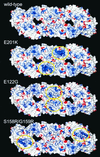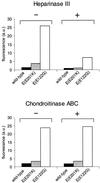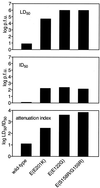Adaptation of tick-borne encephalitis virus to BHK-21 cells results in the formation of multiple heparan sulfate binding sites in the envelope protein and attenuation in vivo
- PMID: 11356970
- PMCID: PMC114275
- DOI: 10.1128/JVI.75.12.5627-5637.2001
Adaptation of tick-borne encephalitis virus to BHK-21 cells results in the formation of multiple heparan sulfate binding sites in the envelope protein and attenuation in vivo
Abstract
Propagation of the flavivirus tick-borne encephalitis virus in BHK-21 cells selected for mutations within the large surface glycoprotein E that increased the net positive charge of the protein. In the course of 16 independent experiments, 12 different protein E mutation patterns were identified. These were located in all three of the structural domains and distributed over almost the entire upper and lateral surface of protein E. The mutations resulted in the formation of local patches of predominantly positive surface charge. Recombinant viruses carrying some of these mutations in a defined genetic backbone showed heparan sulfate (HS)-dependent phenotypes, resulting in an increased specific infectivity and binding affinity for BHK-21 cells, small plaque formation in porcine kidney cells, and significant attenuation of neuroinvasiveness in adult mice. Our results corroborate the notion that the selection of attenuated HS binding mutants is a common and frequent phenomenon during the propagation of viruses in cell culture and suggest a major role for HS dependence in flavivirus attenuation. Recognition of this principle may be of practical value for designing attenuated flavivirus strains in the future.
Figures







Similar articles
-
Resuscitating mutations in a furin cleavage-deficient mutant of the flavivirus tick-borne encephalitis virus.J Virol. 2005 Sep;79(18):11813-23. doi: 10.1128/JVI.79.18.11813-11823.2005. J Virol. 2005. PMID: 16140758 Free PMC article.
-
GAG-binding variants of tick-borne encephalitis virus.Virology. 2010 Mar 15;398(2):262-72. doi: 10.1016/j.virol.2009.12.012. Epub 2010 Jan 12. Virology. 2010. PMID: 20064650
-
Infectious cDNA clone of attenuated Langat tick-borne flavivirus (strain E5) and a 3' deletion mutant constructed from it exhibit decreased neuroinvasiveness in immunodeficient mice.Virology. 2001 Apr 10;282(2):288-300. doi: 10.1006/viro.2001.0846. Virology. 2001. PMID: 11289811
-
Steps of the tick-borne encephalitis virus replication cycle that affect neuropathogenesis.Virus Res. 2005 Aug;111(2):161-74. doi: 10.1016/j.virusres.2005.04.007. Virus Res. 2005. PMID: 15871909 Review.
-
Epidemiology of tick-borne encephalitis (TBE) and phylogenetic analysis of TBE viruses in Japan and Far Eastern Russia.Jpn J Infect Dis. 2001 Feb;54(1):1-11. Jpn J Infect Dis. 2001. PMID: 11326122 Review.
Cited by
-
Multiple genome segments determine virulence of bluetongue virus serotype 8.J Virol. 2015 May;89(10):5238-49. doi: 10.1128/JVI.00395-15. Epub 2015 Mar 11. J Virol. 2015. PMID: 25822026 Free PMC article.
-
Resuscitating mutations in a furin cleavage-deficient mutant of the flavivirus tick-borne encephalitis virus.J Virol. 2005 Sep;79(18):11813-23. doi: 10.1128/JVI.79.18.11813-11823.2005. J Virol. 2005. PMID: 16140758 Free PMC article.
-
Early Events in Japanese Encephalitis Virus Infection: Viral Entry.Pathogens. 2018 Aug 13;7(3):68. doi: 10.3390/pathogens7030068. Pathogens. 2018. PMID: 30104482 Free PMC article. Review.
-
Passage of dengue virus type 4 vaccine candidates in fetal rhesus lung cells selects heparin-sensitive variants that result in loss of infectivity and immunogenicity in rhesus macaques.J Virol. 2009 Oct;83(20):10384-94. doi: 10.1128/JVI.01083-09. Epub 2009 Aug 5. J Virol. 2009. PMID: 19656873 Free PMC article.
-
Vaccine and Wild-Type Strains of Yellow Fever Virus Engage Distinct Entry Mechanisms and Differentially Stimulate Antiviral Immune Responses.mBio. 2016 Feb 9;7(1):e01956-15. doi: 10.1128/mBio.01956-15. mBio. 2016. PMID: 26861019 Free PMC article.
References
-
- Ada G. Overview of vaccines. Mol Biotechnol. 1997;8:123–134. - PubMed
-
- Baeuerle P A, Huttner W B. Chlorate—a potent inhibitor of protein sulfation in intact cells. Biochem Biophys Res Commun. 1986;141:870–877. - PubMed
-
- Berger E A, Murphy P M, Farber J M. Chemokine receptors as HIV-1 coreceptors: roles in viral entry, tropism, and disease. Annu Rev Immunol. 1999;17:657–700. - PubMed
-
- Bernard K A, Klimstra W B, Johnston R E. Mutations in the E2 glycoprotein of Venezuelan equine encephalitis virus confer heparan sulfate interaction, low morbidity, and rapin clearance from blood of mice. Virology. 2000;276:93–103. - PubMed
MeSH terms
Substances
LinkOut - more resources
Full Text Sources
Other Literature Sources

